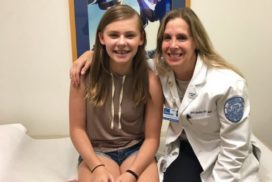PATELLOFEMORAL ARTHRITIS
What is Patellofemoral Arthritis?
Patellofemoral arthritis is diagnosed when there is significant loss or damage of the cartilage between the patella (kneecap) and the trochlea (groove).The knee joint is composed of 3 parts. The patellofemoral compartment (the knee cap and its groove) and the medial and lateral tibiofemoral (inner and outer parts of the knee that you walk on). If the medial and lateral compartments of the knee are affected (in addition to the knee cap), then the diagnosis is more likely generalized osteoarthritis of the knee.
People who develop patellofemoral arthritis generally are diagnosed with one of the following:
- Post-instability arthritis, due to multiple dislocations or subluxations in the joint that results in cartilage damage.
- Post-traumatic arthritis, due to a fall or other traumatic knee injury that results in cartilage damage and then progresses over time to arthritis
- Malalignment or overload arthritis which is generally due to a misalignment of the patella that has been tracking incorrectly for a prolonged period resulting in wearing away of the cartilage on the outside of the kneecap and the groove, and
- General osteoarthritis, a gradually progressive thinning of the cartilage related to “normal wear and tear” that is restricted to, or starts in, the patellofemoral compartment of the knee.
What Are the Symptoms Of Patellofemoral Arthritis?
Patellofemoral knee arthritis symptoms include pain, grinding, stiffness and often swelling in the front part of the knee that is typically worse when going up and down stairs, squatting, or rising from sitting to standing.
What Are the Treatments For Patellofemoral Arthritis?
Non-Surgical Treatment
Treatment for patellofemoral arthritis starts with modifications in activity, such as limiting stairs, squats and lunges, and decreasing high impact sports. Physical therapy is helpful to stretch and strengthen surrounding muscles; and use of non-steroidal anti-inflammatory drugs (NSAIDs) to relieve pain.
Steroid injections can help to reduce inflammation in patients with mild to moderate arthritis experiencing an acute flare-up of their condition (often associated with swelling). Viscosupplementation, is another good option. Viscosupplementation is a substance that mimics naturally occurring joint fluid. It can be injected into the joint to help lubricate and minimize friction and is often helpful in patients with mild to moderate arthritis. In patients who are overweight, weight loss can help reduce the amount of stress on the knee.
PRP and stem cell injections can also be useful in reducing inflammation if the Viscosupplementation injections haven’t worked.
Surgical Treatments
Why is knee cartilage important?
Cartilage is the shiny, smooth coating at the end of bones. It protects the bone and allows the bones to move smoothly and efficiently. Damaged cartilage is known as arthritis. When cartilage thins, or has a piece missing, it puts more stress on the bone and causes pain.
How is the cartilage damaged?
The mechanism of injury for a cartilage defect is usually related to trauma, such as a dislocation that causes the cartilage to scrape along bone, or chronic friction from a maligned knee. The body cannot regenerate this type of cartilage.
What indicates surgical intervention?
These procedures are commonly used to treat patients who have full-thickness focal lesions of the articular cartilage in the knee – ie: the tear extends all the way down to the bone – in either weight-bearing areas between the thigh bone (femur) and the leg bone (tibia) or between the back of the kneecap (patella) and the groove that it slides in (trochlear groove).
How will my cartilage be repaired?
This depends on many factors including your age as well as the size and location of the cartilage defect. The surgeon will chose from one of the following procedures:
– Microfracture
- Procedure: Using arthroscopy, the surgeon will first remove any defective and damaged cartilage tissue from the knee joint. She will then create small holes at the site of your lesion to allow bleeding which will stimulate healing. The new tissue that grows is a hybrid of fibrocartilage and another type of cartilage that is similar to that originally in the joint. Although it is not exactly the same, this new type of cartilage is shown to be durable and to function similarly to the original articular cartilage. This procedure can be used on very small lesions successfully.
– DeNovo
- Procedure: The surgeon will first remove any defective and damaged cartilage tissue from the knee joint. She will then patch the cartilage defect with the DeNovo cartilage cells. This consists of juvenile cartilage which is able to rejuvenate and grow.
- You may require follow-up MRIs at 3 mo, 6 mo, 12 mo, and 24 mo after surgery to follow the growth and maturation of the new cartilage.
– OCA (Osteochondral Allograft)
- Procedure: The surgeon will first remove any defective and damaged cartilage tissue from the knee joint. She will then patch the cartilage defect with a plug of allograft donor cartilage and bone. This does not rejuvenate, but is press fit into the bone. The body then grows into the new plug and it becomes your own.
– MACI (autologous cultured chondrocytes on porcine collagen membrane)
- Procedure: This is a staged surgery. Stage 1- Using arthroscopy, the surgeon will first remove any defective and damaged cartilage tissue from the knee joint. Healthy cartilage is biopsied and sent to a lab where the cartilage cells will proliferate. Stage 2- About 4-6 weeks later, the defect will be patched with your new cartilage cells.
Is this a cure for osteoarthritis (OA)?
No. The above procedures are techniques to stimulate the formation of a new surface to cover only a focal defect in articular cartilage, while OA will affect a more generalized area of cartilage.
How long will I stay in the hospital?
This surgery is done as ambulatory surgery, meaning you will most often go home the same day of surgery.
What are the possible risks and complications of surgery?
As with any surgery there is a risk of DVT (blood clot), nerve damage, and postoperative infection. Specific risks and complications include but aren’t limited to re-injury and post-op stiffness.
When can I drive?
You may not drive while taking pain medication. Additionally, if it is your right knee, you will not be able to drive for approximately 6 weeks after surgery after the brace is removed.
When can I resume jogging and more sport specific activities?
You will not resume jogging until cleared by your physician. This typically is around 6 months after surgery, depending on quadriceps strength. You will be allowed to begin biking without resistance once you have adequate range of motion and will begin this with your physical therapist. Once adequate quad strength is demonstrated you will transition to the Elliptical, running is the next step, and then you may proceed to more sport specific activities. Please see Physical Therapy and Surgical FAQ for more information on this condition.
What makes me a candidate for this surgery?
You are a candidate if you have patellar instability (kneecap dislocation) and focal cartilage injury. This is evaluated through your past history and the use of MRI and XRAY.
What is the medial patellofemoral ligament (MPFL) and how is it damaged?
The MPFL is a ligament that stabilizes the patella (kneecap) and keeps it from displacing laterally. It is disrupted when someone dislocates his/her patella. When the kneecap dislocates towards the outside, this stretches the ligament on the inside of the knee, which is trying to keep the kneecap in place. This can result in either a tear of the MPFL or a detachment of the ligament from the bone.
What is cartilage, why is it important, and how is it injured?
Cartilage is the shiny, smooth coating at the end of bones. It protects the bone and allows the bones to move smoothly and efficiently. Damaged cartilage is known as arthritis. When cartilage thins, or has a piece missing, it puts more stress on the bone and causes pain. The mechanism of injury for a cartilage defect is usually related to trauma, such as a dislocation that causes the cartilage to scrape along bone, or chronic friction from a maligned knee. The body cannot regenerate this type of cartilage.
What does the surgery entail?
This procedure is done through two small open incisions made at the inside portion of the knee and midline along the patella; and through two small arthroscopic incisions. The injured ligament will be replaced with a graft, usually a hamstring tendon from the same leg or a cadaver allograft. The graft is attached to the patella via small absorbable screws that hold the graft in place. The cartilage defect is debrided and restored using one of the methods described below. The incision is then closed with absorbable sutures and Dermabond, a surgical glue.
How will my cartilage be repaired?
This depends on many factors including your age as well as the size and location of the cartilage defect. The surgeon will chose from one of the following procedures:
– Microfracture
- Procedure: Using arthroscopy, the surgeon will first remove any defective and damaged cartilage tissue from the knee joint. She will then create small holes at the site of your lesion to allow bleeding which will stimulate healing. The new tissue that grows is a hybrid of fibrocartilage and another type of cartilage that is similar to that originally in the joint. Although it is not exactly the same, this new type of cartilage is shown to be durable and to function similarly to the original articular cartilage. This procedure can be used on very small lesions successfully.
– DeNovo
- Procedure: The surgeon will first remove any defective and damaged cartilage tissue from the knee joint. She will then patch the cartilage defect with the DeNovo cartilage cells. This consists of juvenile cartilage which is able to rejuvenate and grow.
- You may require follow-up MRIs at 3 mo, 6 mo, 12 mo, and 24 mo after surgery to follow the growth and maturation of the new cartilage.
– OCA (Osteochondral Allograft)
- Procedure: The surgeon will first remove any defective and damaged cartilage tissue from the knee joint. She will then patch the cartilage defect with a plug of allograft donor cartilage and bone. This does not rejuvenate, but is press fit into the bone. The body then grows into the new plug and it becomes your own.
– MACI (autologous cultured chondrocytes on porcine collagen membrane)
- Procedure: This is a staged surgery. Stage 1- Using arthroscopy, the surgeon will first remove any defective and damaged cartilage tissue from the knee joint. Healthy cartilage is biopsied and sent to a lab where the cartilage cells will proliferate. Stage 2- About 4-6 weeks later, the defect will be patched with your new cartilage cells.
How long will I stay in the hospital?
This surgery is typically done as ambulatory surgery, meaning you will go home the same day of surgery.
What are the possible risks and complications of surgery?
As with any surgery there is a risk of DVT, nerve damage, and postoperative infection. Specific risks and complications include but aren’t limited to failure to heal, fracture, and hardware complications.
When can I drive?
You may not drive while taking pain medication. In addition, if it is your right knee that had surgery, you will not be able to drive for approximately 6 weeks after surgery or until the brace is removed.
When can I resume jogging?
You will not resume jogging until cleared by your physician. This typically is around 5-6 months after surgery. You will be allowed to begin biking without resistance once you have adequate range of motion and will begin this with your physical therapist. Once adequate quad strength is demonstrated you will transition to the Elliptical, then running is the next step after that.
When can I return to my sport?
There are many factors in returning to sport after surgery. Most patients are able to return around 7-10 months after surgery. Please see Physical Therapy and Surgical FAQ for more information on this condition.
Am I a candidate for PFJR + MPFL?
You are a candidate if you have patellar instability (kneecap dislocation) and front knee pain with examination findings that point towards kneecap arthritis (patellofemoral osteoarthritis). This is evaluated through the use of MRI and XRAY.
What is osteoarthritis and how does it occur?
Cartilage is the shiny, smooth coating at the end of bones. It protects the bone and allows the bones to move smoothly and efficiently. When this cartilage thins or becomes damaged, it’s called osteoarthritis. It can be caused by a number of factors including genetics and injury.
What is the medial patellofemoral ligament (MPFL) and how is it damaged?
The MPFL is a ligament that stabilizes the patella (kneecap) and keeps it from displacing laterally. It is disrupted when someone dislocates his/her patella. When the kneecap dislocates towards the outside, this stretches the ligament on the inside of the knee, which is trying to keep the kneecap in place. This can result in either a tear of the MPFL or a detachment of the ligament from the bone. Additionally, when the kneecap goes out of place, and then back in, it knocks on the lateral femoral condyle (part of the thigh bone), which can often result in an injury to the cartilage and contribute to arthritis.
What does the surgery entail?
A vertical incision is made in the front of the knee. Focusing on the patellofemoral compartment, the damaged bone and cartilage in the knee joint are removed and the worn ends of the bone are shaped to fit the implant, which is inserted and attached to the bones with cement. The exact type of implants used is called Zimmer. The implants are made of cobalt chrome and high molecular weight plastic. Then, the injured MPFL ligament will be replaced with a graft, usually a quadriceps tendon from the same leg or a cadaver allograft. The graft is attached to the femur via small absorbable screws that hold the graft in place and an attach to the femur. The incision is then closed with absorbable sutures and Dermabond, a surgical glue and tape.
How long will I stay in the hospital?
This surgery is an in-patient procedure, meaning you will stay in the hospital after surgery. You will then be discharged home. Hospital stay is usually a one night stay.
What are the possible risks and complications of surgery?
As with any surgery there is a risk of DVT, nerve damage, and postoperative infection. Specific risks and complications include but aren’t limited to re-tear, infection, fracture, post-op stiffness, hardware complications, and possible conversion to TKR if arthritis develops in the other compartments of the knee in the future.
When can I drive? When can I go back to work?
You may not drive while taking pain medication. In addition, if it is your right knee that had surgery, you will not be able to drive for approximately 6 weeks after surgery or until the brace is removed. The recovery time needed before returning to work varies depending on your type of work, but is at least 3 weeks for office work and 8 weeks for manual labor.
Can I return to jogging, skiing, and other high-impact or contact sports?
If you comply with your physical therapy and post-operative instructions, achieving total muscle recovery, then there are no restrictions on any type of activity. However, studies have shown that, because the implants are mechanical devices, high loads cause them to wear out more quickly, resulting in a higher risk of needing a revision. You should avoid running activities. Please see Physical Therapy and Surgical FAQ for more information.
What is TTT?
A tibial tubercle transfer (also known as a Fulkerson Osteotomy) is a surgical procedure that is used to correct for patellar instability or patellar malalignment. Another indication for a tibial tubercle transfer is patellar osteoarthritis. Depending on what anatomy needs to be addressed and corrected, there are a couple choices for repositioning. This will be determined through the use of physical examination and MRI calculations.
The procedure consists of an incision, which is made a few centimeters below the kneecap (patella) along the top portion of the shin bone (tibia). The patella is embedded in a tendon that inserts on a bony prominence at the shin bone, known as the tibial tuberosity. The patella is repositioned by surgically cutting and moving the attachment on the shin bone. The new position is held through the use of 2 metal screws. The incision is then closed with absorbable sutures and Dermabond, a surgical glue.
How long will I stay in the hospital?
Most patients can go home the same day as their surgery. Occasionally, you will stay overnight. This will allow for better management of your pain. Once you are able to demonstrate successful management of pain, you will be discharged home.
What are the possible risks and complications of surgery?
As with any surgery there is a risk of DVT (blood clot), nerve damage, and postoperative infection. Specific risks and complications include but aren’t limited to failure to heal, fracture, and hardware complications.
When can I drive?
You may not drive while taking pain medication. In addition, if it is your right knee that had surgery, you will not be able to drive for approximately 6 weeks after surgery or until the brace is removed.
When can I resume jogging?
You will not resume jogging until cleared by your physician. This typically is around 6 months after surgery. You will be allowed to begin biking without resistance once you have adequate range of motion and will begin this with your physical therapist. Once adequate quad strength is demonstrated you will transition to the Elliptical, then running is the next step after that.
When can I return to my sport?
There are many factors in returning to sport after surgery. Most patients are able to return around 7-10 months after surgery. Please see Physical Therapy and Surgical FAQ for more information on this condition.
What makes me a candidate for this surgery?
You are a candidate if you have patellar instability (kneecap dislocation), front knee pain, and focal cartilage injury. This is evaluated through your past history and the use of MRI and XRAY.
What is the medial patellofemoral ligament (MPFL) and how is it damaged?
The MPFL is a ligament that stabilizes the patella (kneecap) and keeps it from displacing laterally. It is disrupted when someone dislocates his/her patella. When the kneecap dislocates towards the outside, this stretches the ligament on the inside of the knee, which is trying to keep the kneecap in place. This can result in either a tear of the MPFL or a detachment of the ligament from the bone.
What is cartilage, why is it important, and how is it injured?
Cartilage is the shiny, smooth coating at the end of bones. It protects the bone and allows the bones to move smoothly and efficiently. Damaged cartilage is known as arthritis. When cartilage thins, or has a piece missing, it puts more stress on the bone and causes pain. The mechanism of injury for a cartilage defect is usually related to trauma, such as a dislocation that causes the cartilage to scrape along bone, or chronic friction from a maligned knee. The body cannot regenerate this type of cartilage.
What does the surgery entail?
A tibial tubercle transfer (also known as a Fulkerson Osteotomy) is a surgical procedure that is used to correct for patellar instability or patellar malalignment. The procedure consists of an incision, which is made a few centimeters below the kneecap (patella) along the top portion of the shin bone (tibia). The patella is embedded in a tendon that inserts on a bony prominence at the shin bone, known as the tibial tuberosity. The patella is repositioned by surgically cutting and moving the attachment on the shin bone. The new position is held through the use of 2 metal screws.
Then, the injured MPFL ligament will be replaced with a graft, usually a hamstring tendon from the same leg or a cadaver allograft. The graft is attached to the patella via small absorbable screws that hold the graft in place.
Using arthroscopy, the cartilage defect is debrided and restored using one of the methods described below.
The incision is then closed with absorbable sutures and Dermabond, a surgical glue and tape.
How will my cartilage be repaired?
This depends on many factors including your age as well as the size and location of the cartilage defect. The surgeon will chose from one of the following procedures:
– Microfracture
- Procedure: Using arthroscopy, the surgeon will first remove any defective and damaged cartilage tissue from the knee joint. She will then create small holes at the site of your lesion to allow bleeding which will stimulate healing. The new tissue that grows is a hybrid of fibrocartilage and another type of cartilage that is similar to that originally in the joint. Although it is not exactly the same, this new type of cartilage is shown to be durable and to function similarly to the original articular cartilage. This procedure can be used on very small lesions successfully.
– DeNovo
- Procedure: The surgeon will first remove any defective and damaged cartilage tissue from the knee joint. She will then patch the cartilage defect with the DeNovo cartilage cells. This consists of juvenile cartilage which is able to rejuvenate and grow.
- You may require follow-up MRIs at 3 mo, 6 mo, 12 mo, and 24 mo after surgery to follow the growth and maturation of the new cartilage.
– OCA (Osteochondral Allograft)
- Procedure: The surgeon will first remove any defective and damaged cartilage tissue from the knee joint. She will then patch the cartilage defect with a plug of allograft donor cartilage and bone. This does not rejuvenate, but is press fit into the bone. The body then grows into the new plug and it becomes your own.
– MACI (autologous cultured chondrocytes on porcine collagen membrane)
- Procedure: This is a staged surgery. Stage 1- Using arthroscopy, the surgeon will first remove any defective and damaged cartilage tissue from the knee joint. Healthy cartilage is biopsied and sent to a lab where the cartilage cells will proliferate. Stage 2- About 4-6 weeks later, the defect will be patched with your new cartilage cells.
How long will I stay in the hospital?
With this surgery, you will stay overnight. This will allow for better management of your pain. Once you are able to demonstrate successful management of pain, you will be discharged home.
What are the possible risks and complications of surgery?
As with any surgery there is a risk of DVT, nerve damage, and postoperative infection. Specific risks and complications include but aren’t limited to failure to heal, fracture, and hardware complications.
When can I drive?
You may not drive while taking pain medication. In addition, if it is your right knee that had surgery, you will not be able to drive for approximately 6 weeks after surgery or until the brace is removed.
When can I resume jogging?
You will not resume jogging until cleared by your physician. This typically is around 8-10 months after surgery. You will be allowed to begin biking without resistance once you have adequate range of motion and will begin this with your physical therapist. Once adequate quad strength is demonstrated you will transition to the Elliptical, then running is the next step after that.
When can I return to my sport?
There are many factors in returning to sport after surgery. Most patients are able to return around 7-10 months after surgery. Please see Physical Therapy and Surgical FAQ for more information on this condition.
Am I a candidate for a partial knee replacement?
You are a candidate for a partial knee replacement if you have severe knee pain and examination findings that point towards arthritis of the knee. Additionally, you have tried non-surgical treatments, such as injections and physical therapy, with no relief of symptoms. This surgery is indicated when there is damage to the cartilage in only one compartment of the knee. This is evaluated through the use of MRI and XRAY. Cartilage is the shiny, smooth coating at the end of bones. It protects the bone and allows the bones to move smoothly and efficiently. There are 3 compartments of the knee: medial tibial-femoral (inside part of the knee), lateral tibial-femoral (outside part of the knee), and patellar-femoral (behind the kneecap).
What caused my knee to become arthritic in this compartment?
Knees can become arthritic for a variety of reasons. Because they bear significant stress over the course of our life, some degeneration is simply the result of wear and tear. This can also be due to trauma to the knee, malalignment of the knee, or genetic predisposition.
What happens during a partial knee replacement surgery?
A vertical incision, is made in the front of the knee. Focusing on the compartment being replaced, the damaged bone and cartilage in the knee joint are removed and the worn ends of the bone are shaped to fit the implant, which is inserted and attached to the bones with cement. The exact type of implants used is called Zimmer for the patellofemoral replacement. The implants are made of cobalt chrome and high molecular weight plastic. The incision is then closed with absorbable sutures and Dermabond, a surgical glue and tape. Unlike the total knee replacement (TKR), you will keep your ACL (anterior cruciate ligament), PCL (posterior cruciate ligament), and other compartments of your knee.
How long will my implants last?
The lifetime of the implants varies, depending on the patient’s lifestyle and compliance with post-operative instructions, the fit of the implants, and, of course, chance. However, 90% of patients have functional implants 15 years after their partial knee replacement surgery. The reasons for failure include infection, implant instability, conversion to TKR, or fracture.
How long will I stay in the hospital?
This surgery is can be in-patient procedure, meaning one night stay in the hospital after surgery, or it can be done as ambulatory surgery, meaning you go home the same day of surgery. This is in part determined by your age, health status, and your post-op recovery.
What are the possible risks and complications of surgery?
As with any surgery there is a risk of DVT, nerve damage, and postoperative infection. Specific risks and complications include but aren’t limited to infection, fracture, post-op stiffness, hardware complications, and conversion to TKR if arthritis develops in the other compartments of the knee.
When can I drive? When can I go back to work?
You may not drive while taking the pain medication. Most patients can drive after 3-4 weeks, but it is very important that you make sure you have full control of your injured leg prior to returning to driving. The recovery time needed before returning to work varies depending on your type of work, but is at least 3 weeks for office work and 8 weeks for manual labor.
Can I return to jogging, skiing, and other high-impact or contact sports?
If you comply with your physical therapy and post-operative instructions, achieving total muscle recovery, then there are no restrictions on any type of activity. However, studies have shown that, because the implants are mechanical devices, high loads cause them to wear out more quickly, resulting in a higher risk of needing a revision. You should avoid running activities. Please see Physical Therapy and Surgical FAQ for more information on this condition.










